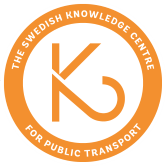Covid-19 has affected the supply, demand, and image of public transport in unprecedented ways. This report aims to investigate the short- and long-term effects of Covid-19 on public transport and its funding models, with specific focus on the Swedish context. Three research questions are in focus: How does Covid-19 impact on revenues and costs for public transport? What measures have public transport agencies made in response to these challenges? How does changes or stability in public transport due to Covid-19, in the longer run impact on the possibility to reach regional political aims of sustainable transport? The research questions are approached with both quantitative and qualitative methods, including interviews and a scenario workshop with mobility actors in Sweden. The three Swedish metropolitan regions, Stockholm, Västra Götaland and Skåne, are used as cases.
The report shows very clearly how farebox revenues drastically decreased in all three regions, as many people listened to the recommendations from authorities to avoid public transport. At the same time, costs remained largely unchanged. This resulted in a widened gap between costs for operating the system, and revenues that could finance those costs. To compensate for the loss of ticket revenues, earmarked state contributions were introduced on several occasions on an ad-hoc basis. Even with state contributions, regional subsidies to public transport increased. The so-called cost-recovery ratio declined in unprecedented ways. Thus, the share of public subsidies coming from tax-money, both regional and national, increased.
The three regions responded in similar ways to the funding challenge, but with some variations. Region Skåne was the only region that downsized operations at an early stage to reduce costs, which caused some political turmoil. Stockholm and Västra Götaland decided to maintain operations unchanged. Increased problems with fare evasion added to the problem of reduced revenues. To meet changes in demand, with more people working from home, new tickets were introduced. Several other measures were implemented to reduce congestion and transmission of disease, such as dispersed school start and improved traffic information. Such measures can impact costs in the longer-term perspective if adopted at larger scale and over longer time.
Future implications of the pandemic on public transport and its funding are difficult to assess. The report includes an analysis based on four different scenarios developed within the project – “Downward spiral”, “Return”, “New mobility systems” and “Public transport as backbone”. The analysis indicates that he public transport actors in particular should try to avoid and be prepared to handle the scenario of “Downward spiral”, but also “Return” and “New mobility systems”, since these scenarios are judged to include difficulties.
Based on institutional theory, three more general reflections are made concerning the impact on future funding models. A first reflection is that the national level has stepped in as an important funder of public transport in Sweden. If demand for public transport remain on a significantly lower level compared to the pre-pandemic situation, continued national funding might be needed to prevent a development in line with the “Downward spiral” scenario. If so, national funding may be part of a new institutional equilibrium that influence power relations and actor’s behavior in the future.
A second observation is that the pandemic might change ideas about public transport’s role in society in ways that transform the existing institutions from within. A larger focus on individual, demand responsive solutions, and measures to reduce crowding will impact funding models. Increased working from home change the basic idea of a public transport system serving a rather fixed commuting behavior. More flexibility will be needed for public transport to remain relevant. We have already seen examples of institutional adjustments in ticket regimes, which is something that may continue at a larger scale.
A third reflection is that the widened funding gap change the cost-benefit equation in public transport. This may have repercussions for the institutional frameworks. In the “Downward spiral” scenario institutions may change mainly from within, with a shift from a focus on societal development and sustainability towards a more budget oriented way of thinking, with cost reductions, revenue maximization, increased ticket prices, and similar measures. To avoid such a development, the national level may need to take a more active role in funding, but also take a more active role as a “meta-governor” that steer the direction of public transport actors. The scenarios, “New mobility systems” and “Public transport as backbone” will require larger institutional makeovers where new funding models are needed to support other forms of shared transport modes. This may in more fundamental ways change the perception of what public transport is and how it should be funded.
